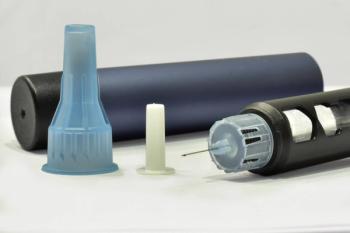
- Drug Topics May 2021
- Volume 165
- Issue 5
Melphalan Flufenamide for Relapsed or Refractory Multiple Myeloma
Melphalan flufenamide (Pepaxto; Oncopeptides AB) in combination with dexamethasone was granted accelerated approval on February 26, 2021, by the FDA for adult patients with relapsed or refractory multiple myeloma.
On February 26, 2021, melphalan flufenamide (Pepaxto; Oncopeptides AB) in combination with dexamethasone was granted accelerated approval by the FDA for adult patients with relapsed or refractory multiple myeloma.1 Relapsed or refractory multiple myeloma is defined in patients who have received at least 4 prior lines of therapy and whose disease is refractory to at least 1 proteasome inhibitor, 1 immunomodulatory agent, and 1 CD38-directed monoclonal antibody. Melphalan flufenamide, a peptide-drug conjugate, targets aminopeptidases and selectively releases alkylating agents into tumor cells.2 Melphalan flufenamide is taken up by myeloma cells because of its lipophilicity. It is rapidly hydrolyzed by peptidases, and cross-linking of DNA is involved in the antitumor activity. Melphalan flufenamide shows synergistic cytotoxicity with dexamethasone in both melphalan-resistant and nonresistant multiple myeloma cell lines.3
Efficacy
Accelerated approval of melphalan flufenamide was based on results of the multicenter, single-arm, phase 2 HORIZON trial (NCT02963493).1 To be eligible for the trial, patients were required to have relapsed or refractory multiple myeloma. They had to have received 2 or more prior lines of therapy and been refractory to at least 1 proteasome inhibitor, 1 immunomodulatory agent, and 1 pomalidomide and/or a CD38-directed antibody. The primary end point was overall response rate (ORR) and the secondary end points included duration of response (DOR), progression-free survival (PFS), overall survival (OS), safety, clinical benefit rate, best response, time to response, time to progression, and time to next treatment.2 The ORR was 29% in the all-treated population (95% CI, 22%-37%), with 26% in the triple-class-refractory population (95% CI, 18%-35%). In the all-treated population, median DOR was 5.5 months (95% CI, 3.9-7.6 months), median PFS was 4.2 months (95% CI, 3.4-4.9 months), and median OS was 11.6 months (95% CI, 9.3-15.4 months) at a median follow-up of 14 months.2
Safety
The most common adverse effects were fatigue (55%), nausea (32%), diarrhea (27%), pyrexia (24%), and respiratory tract infection (24%). The most common grade 3 or 4 laboratory abnormalities were decreases in leukocytes (88%), platelets (80%), lymphocytes (95%), neutrophils (82%), and hemoglobin (50%).3 Melphalan flufenamide carries warnings for thrombocytopenia, neutropenia, anemia, infections, secondary malignancies, and embryo-fetal toxicity. Additionally, this medication should not be interchanged with regular melphalan hydrochloride, such as when prescribed in high doses for conditioning regimens for hematopoietic stem cell transplantation, as higher-than-recommended doses of melphalan flufenamide may be associated with mortality.4
Complete blood counts with differential should occur at baseline, during treatment, and as clinically indicated to monitor for thrombocytopenia, neutropenia, and anemia. Melphalan flufenamide should be withheld if the patient’s platelet count is less than 50 × 109/L or neutrophil count is less than 1 × 109/L. Pharmacists should advise patients to take this medication as prescribed, and patients should be monitored for signs and symptoms of infection while taking this medication. Patients should also be monitored long term for development of secondary malignancies. If applicable, patients should use contraception while on melphalan flufenamide because of the potential embryo-fetal toxicity. For females, contraception should be continued for 6 months after the last dose, and for males, 3 months after the last dose. Although it is unknown if melphalan flufenamide passes into breast milk, patients should be advised to not breastfeed during treatment and for 1 week after the last dose of melphalan flufenamide.3
Dosing
The recommended dosage of melphalan flufenamide is 40 mg intravenously over 30 minutes on day 1 of each 28-day treatment cycle in combination with dexamethasone. A serotonin (5-HT3) receptor antagonist, such as ondansetron, or other antiemetics may be taken to prevent nausea and vomiting.3 If needed because of adverse effects, the first dose reduction would be to 30 mg of melphalan flufenamide and the second dose reduction would be to 20 mg. If the patient cannot tolerate 20 mg, melphalan flufenamide should be permanently discontinued.3
Kendall Szulimowski is a 2021 PharmD candidate at the University of Connecticut School of Pharmacy in Storrs.
Samantha Troy is a 2021 PharmD candidate at the University of Connecticut School of Pharmacy in Storrs.
Lisa M. Holle, PharmD, BCOP, FHOPA, FISOPP, is an associate clinical professor at the University of Connecticut School of Pharmacy in Storrs.
References
- FDA grants accelerated approval to melphalan flufenamide for relapsed or refractory multiple myeloma. FDA. Updated March 1, 2021. Accessed March 18, 2021.
https://www.fda.gov/drugs/drug-approvals-and-databases/fda-grants-accelerated-approval-melphalan-flufenamide-relapsed-or-refractory-multiple-myeloma . - Richardson PG, Oriol A, Larocca A, et al. Melflufen and dexamethasone in heavily pretreated relapsed and refractory multiple myeloma. J Clin Oncol. 2021;39(7):757-767. doi:10.1200/JCO.20.0225
- Pepaxto. Prescribing information. Accessed March 18, 2021.
https://www.accessdata.fda.gov/drugsatfda_docs/label/2021/214383s000lbl.pdf - Melphalan flufenamide: drug information. Accessed March 18, 2021. http://
www.uptodate.com/contents/melphalan-flufenamide-drug-information
Articles in this issue
over 4 years ago
May Is Mental Health Awareness Monthover 4 years ago
Technology Advances Are Needed to Advance the Professionover 4 years ago
Integrating Pharmacists Into Stroke Care Teamsover 4 years ago
COVID-19 Vaccines: A Focus on Safetyover 4 years ago
Rheumatoid Arthritis Treatmentover 4 years ago
Digital Health Tools in Diabetesover 4 years ago
Emerging Roles in Mental Health Care for PharmacistsNewsletter
Pharmacy practice is always changing. Stay ahead of the curve with the Drug Topics newsletter and get the latest drug information, industry trends, and patient care tips.




























































































































